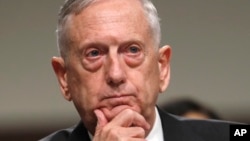U.S. Defense Secretary Jim Mattis says he is satisfied with the process the Trump administration went through to formulate its new strategy for Afghanistan, but he declined to provide details.
Speaking in Amman, Mattis said he will not talk about the policy until it is officially disclosed by the White House.
Trump said Saturday his administration has decided how to deal with the 16-year war in Afghanistan.
One day after meeting at the Camp David presidential retreat with his national security team, Trump tweeted, “Important day spent at Camp David with our very talented generals and military leaders. Many decisions made, including on Afghanistan,” without providing details.
Trump Press Secretary Sarah Huckabee Sanders said Friday a new strategy would “protect America’s interests” in the South Asian region and details would be forthcoming.
Friday’s meeting was the most recent in a series of high-level talks on a broader security strategy for Afghanistan and the greater South Asia region. Finalizing a strategy has been delayed by internal differences.
Among the attendees were Vice President Mike Pence and Defense Secretary James Mattis.
Without offering hints, Mattis told reporters Thursday in Washington he anticipated a decision on the new approach to the war, the longest in U.S. history, would be made “in the near future.
Before a new strategy is adopted, the administration has said it would review its approach to the broader South Asia region, including Pakistan and India. Options include sending thousands of additional troops to the war-torn country or withdrawing them altogether, leaving private military contractors to help manage the country's tenuous security situation.
After years of extensive support from the U.S. and other NATO member nations, the Afghan military is still struggling to resist the Taliban, which recently made advances in Afghanistan and the Pakistan border region. U.S. generals have described the conflict as a "stalemate."
The U.S. Defense Department approved a plan months ago to send about 3,800 additional troops to assist the Afghan army, but some White House officials questioned whether more resources would be effective.
Trump authorized Mattis to determine troop numbers in Afghanistan, but several months later, allied troop levels remain unchanged. About 8,400 U.S. troops and an estimated 5,000 NATO troops are in the country, serving primarily in advisory and training capacities. The United States also maintains a force in Afghanistan that is tasked with fighting terrorist groups, including Islamic State and al-Qaida.










